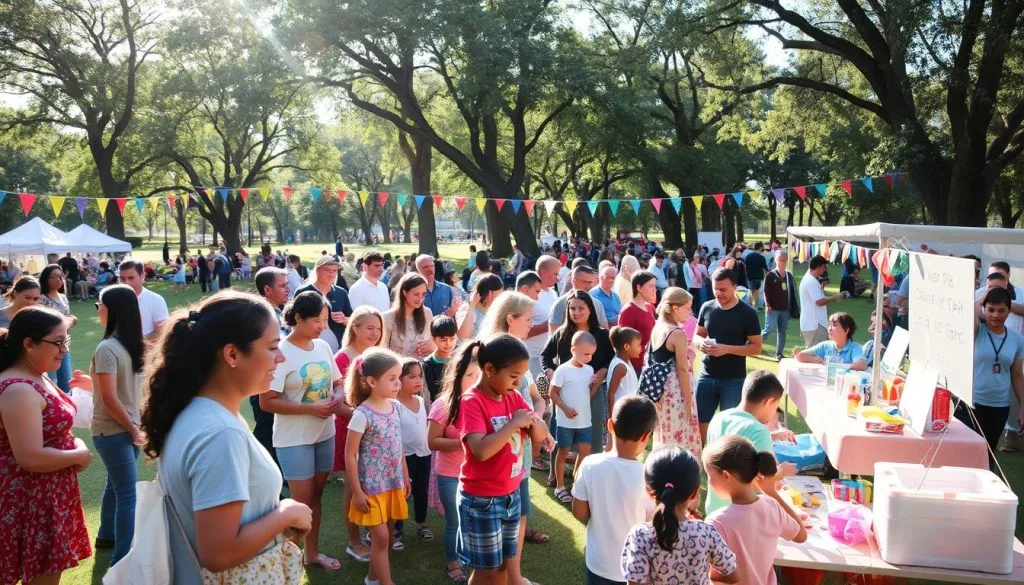In a vibrant city, a community center was a beacon of hope for youth. Amelia Jackson led a team of volunteers on a mission to empower Black leaders. Their story shows the power of outreach in changing lives.
Amelia, a former teacher, saw the challenges Black youth faced. She gathered mentors and leaders to create a program. It offered support, career guidance, and cultural enrichment. Their goal was to build a strong community and empower youth.
Key Takeaways
- Fostering a strong sense of community within children’s ministry programs can enhance spiritual growth and engagement among young participants.
- Building meaningful connections and nurturing inclusivity are crucial in empowering Black youth to reach their full potential.
- Comprehensive outreach programs that address the unique needs of Black youth can have a transformative impact on their lives.
- Dedicated community leaders and mentors can play a pivotal role in inspiring and guiding the next generation of Black leaders.
- Addressing the diverse range of academic, social, and emotional needs of Black youth is essential for their holistic development.
Understanding the Importance of Outreach Programs
Community outreach programs have empowered Black youth for years. They offer engaging activities and a child-centered approach. This helps with personal growth, education, and feeling included.
The Legacy of Outreach in Black Communities
Outreach programs in Black communities have a long history. They started during the civil rights movement. These programs give youth safe places, mentorship, and chances to discover their talents.
They range from after-school tutoring to arts and sports. Outreach helps grow the next leaders.
Current Challenges Facing Black Youth
Black youth still face big challenges today. These include barriers in education, jobs, and well-being. Poverty, violence, and lack of resources are big obstacles.
Outreach programs try to help by offering support and a sense of belonging. They aim to overcome these challenges.
“Outreach programs are a lifeline for Black youth, providing them with the tools and opportunities they need to thrive in the face of adversity.”
Understanding outreach’s history and ongoing role is key. It shows how these programs change Black youth’s lives. Through engaging activities and a child-centered approach, outreach remains a source of hope and change.
Key Elements of Successful Outreach
Creating effective outreach programs for Black youth needs careful thought. It’s about building trust and engaging in ways that feel right. The goal is to make real connections that change lives.
Building Trust with Communities
Trust is the base of any good outreach effort. By being real and listening well, groups can make a safe space. This lets Black youth feel free to share and join in.
This trust helps create interactive lessons and purposeful play that speak to their lives. It’s all about understanding and valuing their culture and experiences.
Culturally Relevant Programming
Outreach programs must reflect the community’s culture and values. They should celebrate Black heritage and traditions. This makes youth feel seen and valued.
By doing this, programs help youth find their pride and identity. They encourage interactive lessons, faith-based bonding, and purposeful play. This leads to lasting, positive change.
Good outreach focuses on trust and cultural connection. It unlocks the potential in youth, helping them see their worth. They become more engaged in interactive lessons and faith-based bonding.

Strategies for Impactful Outreach
Building a community in children’s ministry is key. It helps in making connections and being inclusive. To make a real difference, try these strategies:
Engaging Families and Communities
Don’t just focus on the kids. Reach out to their families and the whole community too. Get parents involved, host events for families, and work with local groups. This way, you support kids’ growth in a big way.
Utilizing Diverse Media Channels
Use many ways to talk to people, old and new. Social media, videos, and online games can all help. Make sure your messages fit what the community needs and likes.
Evaluating Program Effectiveness
Check how well your programs work often. Ask for feedback, watch how people engage, and look at the numbers. This helps you make your programs even better for the kids and their families.
“By building connections and nurturing inclusivity, we can create a lasting impact on the lives of children and their families.”
Using these methods will make your outreach programs really connect with the community. It will help kids and families feel like they belong and grow strong.
Collaborations with Local Organizations
Building strong ties in the community is key for outreach programs aimed at black youth. By teaming up with local schools and nonprofits, groups can use their resources and knowledge. This helps make their efforts more effective and focused on the needs of children.
Partnering with Schools
Working with schools gives a direct way to reach black youth and their families. School programs can offer help with schoolwork, mentorship, and fun activities. This partnership helps organizations understand what students need and adjust their services.
Working with Nonprofits
Nonprofits know the local community well and its challenges. By teaming up with them, outreach programs can use their networks and resources. This teamwork leads to more effective and wide-reaching community efforts.
Successful partnerships need clear communication, a shared goal, and a focus on black youth’s needs. When schools, nonprofits, and community groups work together, they create a supportive space. This space empowers young people and helps them grow personally and academically.

“When we work together, we can create transformative change for the youth in our community.”
Leveraging Technology for Outreach
In today’s world, technology is key for outreach programs aimed at Black youth. It helps them reach more people and build strong bonds in their communities.
Social Media as a Tool for Engagement
Social media is a big deal for reaching Black youth. Programs use it to share interactive lessons, encourage faith-based bonding, and show off purposeful play. Being active on Instagram, TikTok, and Facebook helps them connect and spread their message.
Online Resources and Virtual Events
Outreach programs also use online tools and virtual events. They make educational and inspiring content like webinars and videos. This way, they can reach more youth, even if they can’t meet in person. Virtual events also help build community and faith-based bonding.
| Technology-Powered Outreach Strategies | Benefits |
|---|---|
| Social Media Engagement |
|
| Online Resources and Virtual Events |
|
Technology helps outreach programs reach more Black youth. It boosts community engagement and offers interactive lessons and purposeful play. These are key for the all-around growth of the young people they help.
Creating Mentorship Opportunities
Mentorship programs are key for Black youth growth. They offer guidance, support, and a sense of community. This can change young lives for the better.
Establishing Mentorship Programs
Good mentorship for Black youth pairs them with trusted adults. These adults act as role models and supporters. Programs are set up in local places like schools and community centers.
They give mentors and mentees a place to connect and share interests. This helps build strong relationships.
Benefits of Peer Mentorship
Peer mentorship is also powerful. It connects Black youth with peers who’ve gone through similar things. This creates a bond of understanding and support.
It helps young people feel part of a community. It also encourages them to lead and support others. This builds inclusivity and empowers them to make a difference.
| Mentorship Program Elements | Adult-Led Mentorship | Peer Mentorship |
|---|---|---|
| Guidance and Role Modeling | ✓ | – |
| Shared Experiences and Understanding | – | ✓ |
| Fostering Inclusivity and Leadership | – | ✓ |
| Building Strong Connections | ✓ | ✓ |
Supporting both adult-led and peer mentorship helps Black youth. It gives them the tools to reach their goals and succeed in their communities.
“Mentorship has the power to transform lives, providing young people with the guidance, support, and role models they need to succeed. It’s a critical component in building a more equitable and inclusive future.”
Funding and Resource Allocation
Getting funding and managing resources is crucial for any community outreach program, especially for black youth. Finding funders and writing grant proposals can be tough. But, with the right strategies, organizations can get the resources needed to make a difference.
Identifying Potential Funders
Looking for different funding sources is important for impactful community outreach efforts. You can look at foundations, government agencies, and corporate giving programs. Researching grants and connecting with similar groups can help find the best funding partners for your child-centered approach.
Grant Writing Tips for Outreach Programs
Writing a strong grant proposal is key to getting the funds you need. Start by clearly stating your program’s mission, goals, and what it aims to solve. Show the program’s success with data and personal stories. Also, talk about your team’s skills and your organization’s past successes.
Make sure to meet all the application requirements. This will help your proposal stand out. Remember, deadlines and guidelines are important.
| Funding Source | Focus Area | Grant Range | Application Deadline |
|---|---|---|---|
| ABC Foundation | Youth Development | $20,000 – $50,000 | June 30th |
| XYZ Corporation | Community Engagement | $10,000 – $25,000 | September 15th |
| State Department of Education | After-school Programs | $50,000 – $100,000 | December 1st |
By focusing on funding and resource management, organizations can get the support needed. This support helps deliver impactful community outreach programs. These programs can greatly improve the lives of black youth.
Engaging Youth in Program Development
Involving young people in decision-making is key for building community in children’s ministry. It helps in creating programs that meet the unique needs and views of the youth. This approach makes outreach efforts more effective.
Involving Youth in Decision Making
Empowering youth to help shape outreach programs can greatly impact their success. When young people feel their voices are heard, they are more likely to stay involved. Here are some ways to involve youth:
- Establishing youth advisory councils to provide regular feedback and input
- Hosting collaborative planning sessions where youth can share their ideas
- Encouraging youth to take on leadership roles within the program
Gathering Feedback for Improvement
It’s crucial to regularly gather feedback from youth to improve programs. By listening to their needs and challenges, organizers can make better adjustments. This ensures the programs are relevant and engaging.
Here are ways to gather youth feedback:
- Conducting surveys and questionnaires
- Hosting focus groups and open dialogues
- Encouraging youth to share their experiences and ideas through creative mediums, such as art, writing, or video
By valuing the perspectives of young people, organizations can build stronger communities. They foster meaningful connections and create more inclusive and impactful children’s ministries.
Success Stories of Effective Outreach
In the United States, outreach programs are changing lives for Black youth. They focus on interactive lessons, faith-based bonding, and purposeful play. These efforts are leading to a brighter future. Here are some inspiring stories and testimonials that show the power of these programs.
Case Studies from Various States
In California, “Empowering Minds” is a beacon of hope for inner-city youth. It offers mentorship, STEM workshops, and outdoor adventures. Amelia, a graduate, said, “This program showed me my potential and gave me the courage to dream big.”
In Georgia, “Uplift” uses faith to build strong communities. It hosts weekly youth gatherings with interactive lessons and faith-based bonding. This has led to fewer youth getting involved in crime and substance abuse.
In New York, “Bright Futures” uses purposeful play for growth and community engagement. It includes team-building, art, and outdoor activities. Participants learn important skills and make lasting friendships.
Inspirational Youth Testimonials
“This program has been a life-changing experience for me. The mentors and staff have become like a second family, and the skills I’ve learned have opened up so many doors for my future.” – Jamal, 17, from Chicago
Young people from all over are sharing their stories. They talk about finding purpose, discovering talents, and growing personally. These experiences have a lasting impact.
These success stories show outreach programs are making a real difference. They inspire hope and empowerment in Black youth and their communities. By supporting these initiatives, we can unlock the potential of the next generation and create a more inclusive future.
Overcoming Barriers to Participation
Community outreach programs for Black youth face challenges. Two big ones are transportation and technology access. These barriers need to be tackled to ensure everyone can join in.
Addressing Transportation Challenges
Many Black communities struggle with public transportation. This makes it hard for families to get kids to activities. To solve this, outreach programs can:
- Provide shuttle services or organize carpools
- Work with local groups to offer cheap transportation passes
- Choose locations close to where kids live
Accessing Technology Resources
Today, many programs use technology for events and learning. But, not all families have internet or devices. To help, programs can:
- Give out tablets, laptops, or internet hotspots
- Team up with schools or libraries for computer access
- Teach families how to use the technology
By tackling these issues, programs can make sure all Black youth can join. This includes those with limited transportation or technology.
| Transportation Solutions | Technology Access Strategies |
|---|---|
|
|
The Future of Outreach for Black Youth
Outreach programs are changing, bringing new ways to help Black youth. They use the latest technology and involve the community more. These changes promise to make outreach more powerful and meaningful.
Innovations on the Horizon
Outreach now uses digital tools to connect better with Black youth. They offer virtual mentorship, online workshops, and educational experiences. These new methods reach more people and help them feel connected.
Encouraging Community Involvement
Getting the community involved is key for outreach’s future. Working with local groups and businesses helps outreach programs. This way, they create programs that really speak to the youth. It also helps young people make a difference in their communities.
